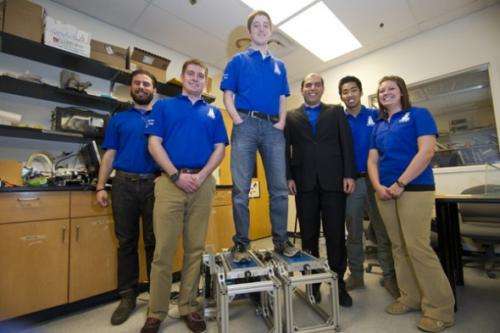The virtually interfaced robotic ankle and balance trainer is designed to help people with ankle injuries regain strength and balance. Credit: Brooks Canaday
Ten months ago, Paul Douçot began contemplating his transition from undergraduate mechanical engineering studies to a graduate program in physical therapy. "I didn't want to abandon my engineering background," he said.
It turned out he wouldn't have to.
Douçot connected with a variety of physical therapists in the field and learned that one sorely lacking piece of technology was an adequate strength and balance trainer for people with ankle injuries. The current systems are simply designed, don't address balance problems, and cost upwards of $60,000.
Several years earlier, Constantinos Mavroidis, Distinguished Professor of Mechanical and Industrial Engineering, and associate professor of physical therapy Maureen Holden had teamed up to provide something better to the field, but when Douçot met them, the system was still inadequate. He assembled a team of four other mechanical engineering students to tackle the challenge for their senior capstone project.
Douçot, JP Valenzuela, Alex Mazzotta, Alexandra Bugliari, and Nate Lavins, didn't limit themselves to the earlier designs of Mavroidis' previous students. "Instead of building off the old design, giving us a clean slate opened up a lot of possibilities," said Bugliari.
They designed and fabricated what they call the Virtually Interfaced Robotic Ankle and Balance Trainer, or vi-RABT, which provides functionality never before seen in the field. The team worked under the guidance of Holden, Mavroidis, and graduate researcher Amir Farjadian and received funding from a Provost Undergraduate Research Award for their work.
Two million people annually suffer from ankle injuries, many due to the motor-skill impairments that come with stroke and other neurological disorders, Holden said. As a result, treatment must involve both strength and balance training, but currently no system can do both.
Developed in Mavroidis' Biomedical Mechatronics Laboratory in collaboration with Holden's lab in physical therapy, the vi-RABT device is equipped with two independent foot platforms that can rotate with two degrees of freedom and are constantly collecting data through a host of pressure sensors embedded within. Because vi-RABT can apply both assistive and resistive forces to the foot, it can be used across the range of physical-therapy treatment protocols.
The data collected by the sensors is doubly valuable: For one, it can be used to guide a virtual avatar through an on-screen maze, creating an engaging game to make the rehabilitation process more enjoyable. Additionally, the data can be stored and used to assess patient improvement over time. Farjadian is carrying out this sophisticated programming implementation.
At RISE:2013, the research, innovation and scholarship expo hosted by the Center for Research Innovation in March, vi-RABT won the people's choice award—indicating the crowd's confidence in the system's commercial promise. On a mass production basis, vi-RABT would cost less than one-third of the less versatile systems currently on the market. The group hopes to commercialize the device within the next two years.
The team intends to carry the device to that next step. Students have continued to optimize it following their capstone presentation this month. Farjadian will develop the practical control software necessary to use it as a physical-therapy tool. Douçot and Holden will begin testing it with healthy subjects over the summer, and Holden already has stroke patients lined up for their turn on the vi-RABT, she said.
Provided by Northeastern University






















